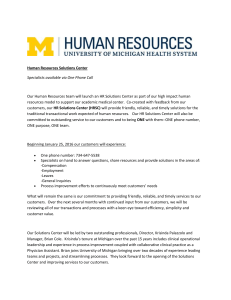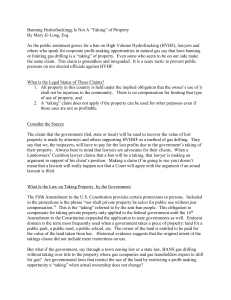Powerpoint version - Community Rights Counsel
advertisement
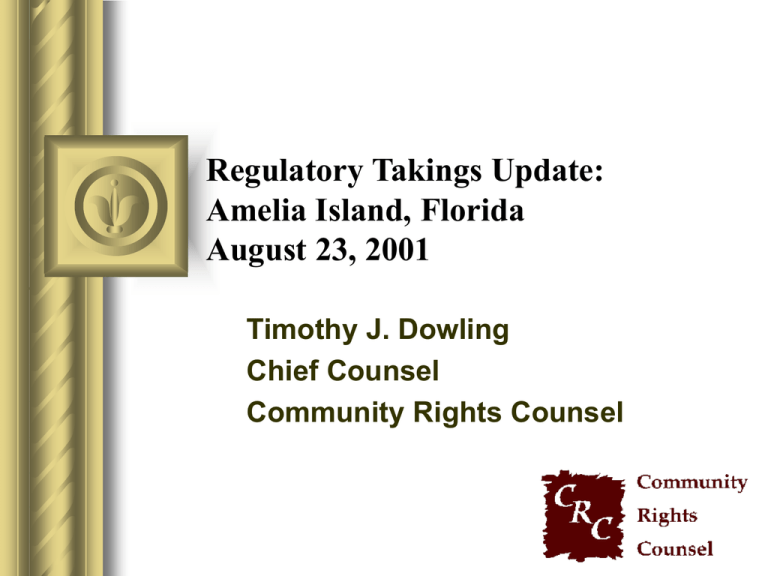
Regulatory Takings Update: Amelia Island, Florida August 23, 2001 Timothy J. Dowling Chief Counsel Community Rights Counsel Community Rights Counsel Nonprofit public interest law firm Assists local governments in defending land use controls and other community protections Emphasis on takings cases Close working relationship with the International Municipal Lawyers Association Community Rights Counsel Cases Rhode Island wetland protections (Palazzolo) Mamaroneck, NY open space protections Lake Tahoe planning moratoria Washington, DC historic preservation laws Anchorage fair housing laws San Francisco tenant protections Riverside, CA fire safety protections Pennsylvania & Ohio bans on harmful coal mining Palazzolo v. Rhode Island 121 S. Ct. 2448 (June 28, 2001) 5-4 win for landowner “Movement” case handled by Pacific Legal Foundation in the Supreme Court Elderly claimant: 80-year-old Anthony Palazzolo The Palazzolo Court “[S]ome, but not too specific, guidance” since Pennsylvania Coal Co. v. Mahon (1922) Palazzolo: Six Opinions Justice Kennedy (Majority) -- joined by Chief Justice Rehnquist and Justices O’Connor, Scalia, and Thomas Justice O’Connor (Concurrence) Justice Scalia (Concurrence) Justice Stevens (Dissent) Justice Ginsburg (Dissent) Justice Breyer (Dissent) Palazzolo’s Coastal Wetlands Palazzolo’s Coastal Wetlands Palazzolo’s Coastal Wetlands Palazzolo’s Coastal Wetlands Ownership History In 1959, Shore Gardens buys the land for $13,000 Subdivides the land into 80 lots Sells off six upland lots for a profit In 1978, Palazzolo personally acquires the remaining 74 lots from defunct Shore Gardens Regulatory History In 1971, Rhode Island enacts coastal protection legislation creating the state Coastal Resources Management Council The Council issues rules prohibiting the filling of coastal wetlands like Palazzolo’s Special exception to the ban where the fill serves a “compelling public purpose” Application History 1962 -- Shore Gardens applies to fill all 18 acres; denied because the application was incomplete 1963 -- Second application to fill 18 acres 1966 -- Third application to fill 11 acres for a beach club Both applications are referred to the Rhode Island Dep’t of Natural Resources, which initially approved them, but shortly thereafter the approval is withdrawn due to environmental harm Application History (continued) Council wetland rules become effective; Palazzolo personally acquires the property in 1978 1983 -- Palazzolo applies to fill all 18 acres of wetlands; no purpose specified; application denied because it was “vague and inadequate” 1985 -- Palazzolo applies to fill 11 acres to build a private beach club; application denied because the proposal did not serve a “compelling public purpose” A Private Beach Club? Justice Kennedy: “The details of the [beach club] proposal do not tend to inspire the reader with an idyllic coastal image, for the proposal was to fill 11 acres of the property with gravel to accommodate ‘50 cars with boat trailers, a dumpster, port-a-johns, picnic tables, barbecue pits of concrete, and other trash receptacles.’” Justice Ginsburg: “a most disagreeable beach club… [T]o get to the club’s water, i.e. Winnepaug Pond rather than the nearby Atlantic Ocean, ‘you’d have to walk across the gravel fill, but then work your way through approximately 75 feet of marsh land…’” Palazzolo’s Takings Suit Palazzolo seeks $3,150,000 based on profits allegedly expected from 74 single-family homes Undisputed that he may build at least one single -family house: land worth $200,000 (1986 dollars) Trial Court Ruling No Taking Proposed subdivision = a nuisance due to septic tank contamination of community drinking water supplies Proposed wetland destruction = a nuisance due to harm to fish populations Not denied all economically viable use No interference with expectations because Palazzolo knew about state wetland protections when he acquired the property in 1978 Rhode Island Supreme Court Ruling Not ripe because Palazzolo never applied for the subdivision Not ripe because record fails to show the extent to which land may be developed No taking under Lucas because pre-existing wetland protections were “background principles” No taking under Penn Central because preexisting wetland protections defeated any expectation to fill the property Not denied all economically viable use Summary of U.S. Supreme Court Rulings Case is ripe Claim is not barred simply because Palazzolo acquired the land after the wetland rules were issued No per se take under Lucas because the land retained significant value The Ripeness Ruling: Finality Reaffirms the basic ripeness rules: agency must reach a final decision (Williamson County) and the final decision must inform the court of the extent of permitted development (MacDonald) The “unequivocal nature” of the wetland protections showed that no fill would be allowed: “There is no indication that the Council would have accepted the application had petitioner’s proposed beach club occupied a smaller surface area.” The Ripeness Ruling: Finality (continued) Court reaffirms “the important proposition” that a regulatory takings case is not ripe until the agency has the chance “to decide and explain the reach of a challenged regulation” The briefs and oral argument clarified that the Council would not allow filling of any wetlands for any purpose. Thus, “further permit applications were not necessary to establish this.” But what if the briefs and argument hadn’t been so clear? Did the case ripen through briefing and argument? The Ripeness Ruling: Other Upland Development Rhode Island: Palazzolo might be able to build on other upland portions of the land The Court: State failed to make this point clearly in its cert. opposition Justice Ginsburg: State had no incentive to show that Palazzolo could build more than one house because the claim in state court was a Lucas claim; PLF switched the claim to a Penn Central claim and then misrepresented the facts in its cert. petition; Court should not become “supreme topographical factfinder” and resolve ambiguities in Palazzolo’s favor The Ripeness Ruling: Hypothetical Uses Rhode Island and amici: Palazzolo failed to apply for the subdivision proposal that formed the heart of his takings claim as litigated The Court: this failure goes only to damages, not ripeness The Court reaffirms that bait-and-switch issue is a “valid concern”; state law may impose additional ripeness rules and “normal planning procedures” to control damage awards based on hypothetical uses The Ripeness Ruling: Confusion Compare: “[T]here is no indication that any use involving substantial structures or improvements would have been allowed.” with Where the “denial of the application makes clear the extent of development permitted ... federal ripeness rules do not require the submission of further and futile applications ...” The “Notice Rule” Ruling Post-enactment acquisition is not an absolute bar to a takings challenge to a statute or regulation Fairness concerns Nollan footnote controls: “prior owners must be understood to have transferred their full property rights in conveying the lot.” Statutes and Rules May Be Background Principles “We have no occasion to consider the precise circumstances when a legislative enactment can be deemed a background principle of state law or whether those circumstances are present here.” Background principles may include “an existing, general law” Background principles include any “common, shared understandings of permissible limitations derived from a State’s legal tradition.” See also Justice Kennedy’s concurrence in Lucas: the entirety of a State’s legal tradition determines whether taking occurs Palazzolo: Expectations Analysis Justice O’Connor plus four dissenters: Pre-existing statutes and rules are relevant to Penn Central No other Justice joined Scalia’s view to the contrary The Lucas Per Se Rule $200,000 in value (6.4% of claimed value) defeats a Lucas per se claim; a 93.6% value loss is not enough to trigger the Lucas per se rule “Token interest” does not defeat a Lucas claim Palazzolo describes Lucas test both in terms of “use” and “value” Palazzolo: Concluding Observations 1. Both sides claim victory 2. No discussion of the value of wetlands 3. More charged rhetoric from Justice Scalia 4. More rhetorical flourish from the Court in favor of takings claimants Tahoe-Sierra Preservation Council, Inc. v. Tahoe Regional Planning Agency, 216 F.3d 764 (9th Cir. 2000), cert. granted, 121 S. Ct. 2589 (June 29, 2001) “Whether the Court of Appeals properly determined that a temporary moratorium on land development does not constitute a taking of property requiring compensation under the Takings Clause of the United States Constitution?” Lake Tahoe Picture #1 Lake Tahoe Picture #2 Tahoe Facts Lake losing one foot of clarity every year due to uncontrolled development 32-month planning moratorium to allow for preparation of a regional growth plan 450 landowners brought facial takings claim Tahoe: Trial Court Moratorium reasonable in scope and duration No interference with reasonable expectations (average holding period in the Tahoe Basin = 25 years) No Penn Central Taking Per se taking under Lucas Tahoe: Ninth Circuit No Lucas Taking Must consider all uses, including future uses Cannot “temporally sever” the landowners’ property interests (parcel-as-a-whole rule) Agins v. City of Tiburon, 447 U.S. 255 (1980) -“mere fluctuations in value during the process of government decisionmaking, absent extraordinary delay . . . cannot be considered a ‘taking’ . . .” Tahoe: In the Supreme Court Key issue = meaning of the Court’s 1987 ruling in First English The only claim before the Court is the Lucas claim The trial court found that none of the land is “valueless” The moratorium was reasonable in scope and duration Restrictions under the two regional plans are not before the court
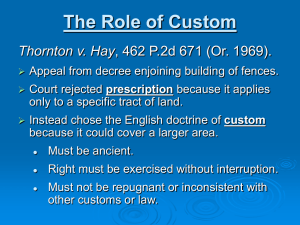
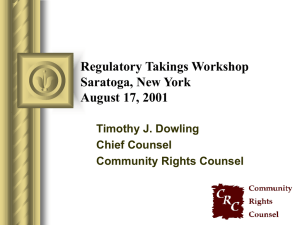
![3-hour presentation [Powerpoint version]](http://s3.studylib.net/store/data/009397762_1-c22e220e752e4a512b34756c3ee96c3c-300x300.png)
